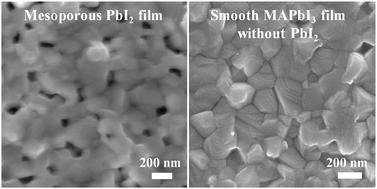Control of the morphology of PbI2 films for efficient perovskite solar cells by strong Lewis base additives†
Abstract
A two-step method is widely used to fabricate highly efficient perovskite solar cells. In a typical two-step method, CH3NH3PbI3 perovskites are fabricated from PbI2 films through an intercalation reaction between PbI2 and CH3NH3I, which usually have a rough surface and residual PbI2 due to a compact PbI2 structure. Here, we introduce some strong Lewis bases into PbI2/DMF solutions in the first step, which is helpful in controlling the morphology of PbI2 films with a mesoporous structure. The mesopores in the PbI2 films provide not only space for accommodating the volume expansion during the reaction between PbI2 and CH3NH3I, but also channels for CH3NH3I solution to diffuse into the PbI2 films, which helps eliminate the residual PbI2 and the dissolution and recrystallization process. As a result, smooth perovskite films without residual PbI2 are easily obtained. The power conversion efficiency, stability and reproducibility of the perovskite solar cells fabricated from the optimized mesoporous PbI2 films improved simultaneously due to the improvement in perovskite films. This work reveals the key roles of solvents (boiling point, Lewis basicity) in controlling the microstructure of the PbI2 films.



 Please wait while we load your content...
Please wait while we load your content...